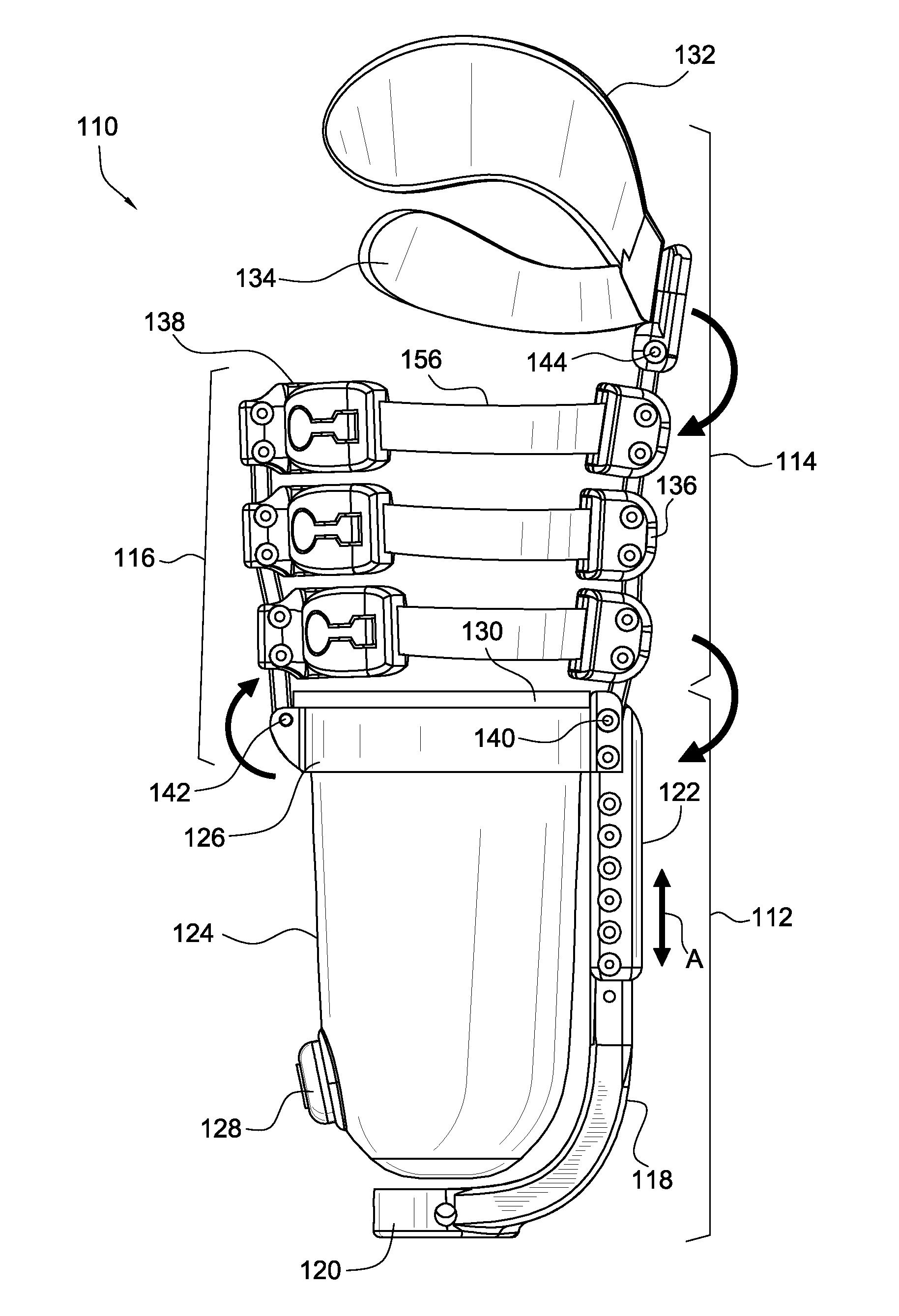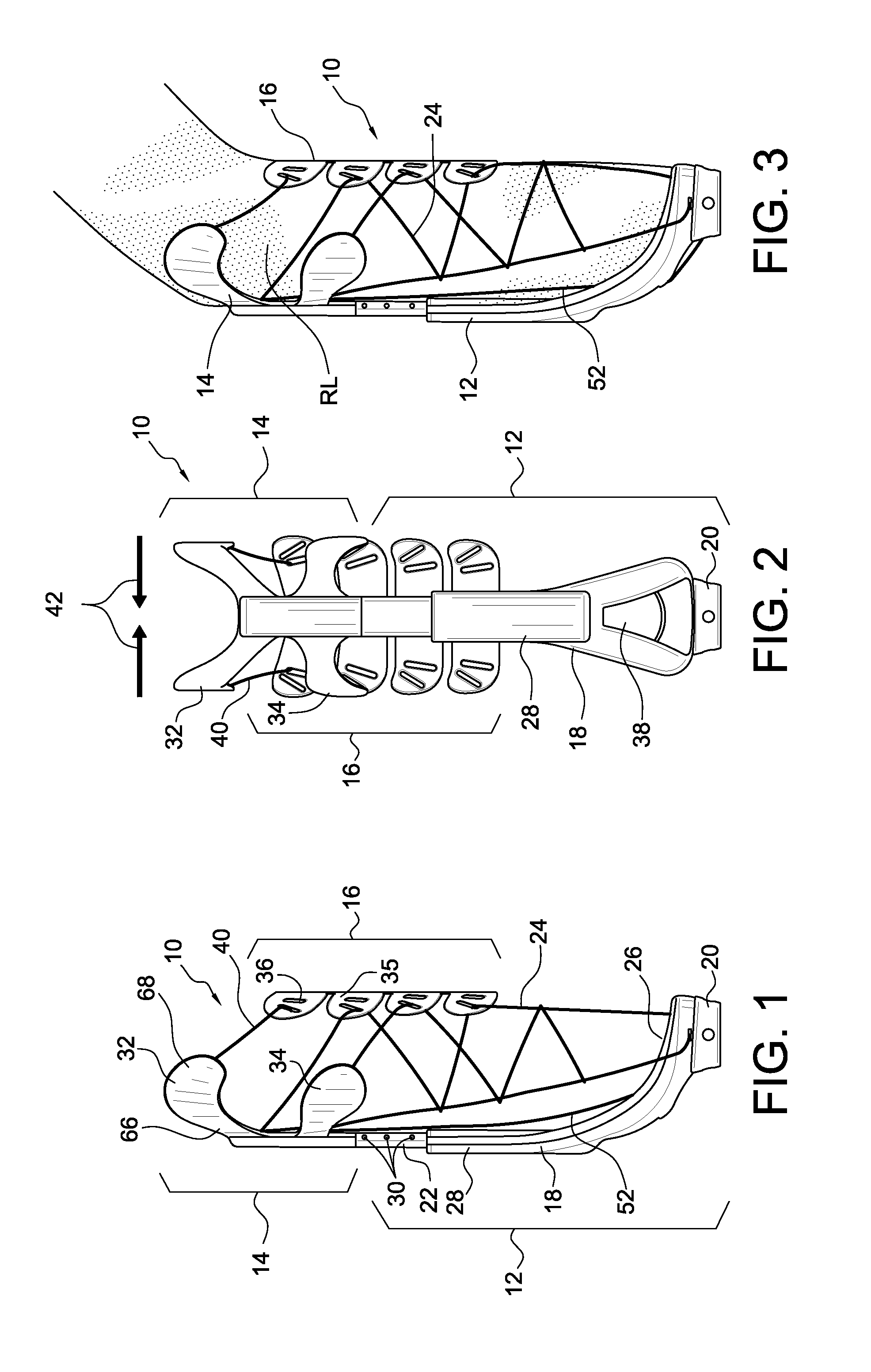Adjustable socket system
a socket and adjustment technology, applied in the field of adjustable sockets, can solve the problems of affecting the fitting and alignment of the socket, affecting the function of the socket, so as to reduce pain, discomfort and soft tissue breakdown
- Summary
- Abstract
- Description
- Claims
- Application Information
AI Technical Summary
Benefits of technology
Problems solved by technology
Method used
Image
Examples
first embodiment
[0056]1. First Embodiment of the Socket System
[0057]a. Strut Device
[0058]The strut device is connected to a flexible network of straps forming the strap system, the semi-flexible clamp elements and a prosthetic component system, such as a foot, pylon and other components.
[0059]The strut device 12 has a strut base 18 forming a limb receiving portion or seat 26 adapted to receive a distal end portion of a residual limb and an anterior opening 38 arranged for ventilating the rigid strut and accommodating minor fluctuations of the volume of the residual limb.
[0060]A base connector 20 is secured to a bottom portion of the strut base 18, and is adapted to connect to prosthetic components, such as an artificial foot, and serve as a connection point for various straps of the strap system. The strut base 18 forms a sleeve 28 at an upper part thereof, and an adjustable strut 22 slidably engages the sleeve 28 and is lockable at a plurality of predefined height settings 30.
[0061]The limb seat 2...
second embodiment
[0082]2. Second Embodiment of the Socket System
[0083]FIG. 9 depicts another embodiment of the adjustable socket system 110. According to this embodiment, the socket system 110 includes a distal component 112 adapted to rigidly secure to a residual limb, a proximal anterior component 114 secured to the distal component 112, and a distal posterior component 116 connected to the distal component 112 and the proximal anterior component 114.
[0084]The distal component 112 defines a strut base 118 having a base connector 120 defined at a distal end for securing to a prosthetic component system (not shown), such as a foot, pylon and other component. A telescoping strut 122 is slidably and lockingly secured to a proximal end of the strut base 118. The distal component 112 includes a cup 124 adapted to secure to at least a distal portion of the residual limb, and having a valve 128. A ring 126 secures to the telescoping strut 122 and supports the cup 124 with a retaining rim 130 formed by the...
third embodiment
[0102]3. Third Embodiment of the Socket System
[0103]FIG. 19 shows another embodiment of the adjustable socket system 210. The socket system 210 includes a rigid spine 216 on the posterior side, a flexible spine 218 on the anterior side, a proximal support 224, lateral flaps 226 extending from either side of the spines 216, 218, and a distal base formed of a posterior distal base component 228 and an anterior distal base component 230. The socket system 210 may be adjusted to the shape and size of the residual limb by adjusting the length of a cable 212 which is threaded around the socket using a dial tensioner 214. The circumference of the socket system 210 may also be adjusted by changing the positions of the distal base components 228, 230. The height of the socket system 210 may further be modified to accommodate the length of residual limb by adding or removing anterior vertebrae 220 and posterior vertebrae 222 to and from the flexible spine 218 and the rigid spine 216, respecti...
PUM
 Login to View More
Login to View More Abstract
Description
Claims
Application Information
 Login to View More
Login to View More - R&D
- Intellectual Property
- Life Sciences
- Materials
- Tech Scout
- Unparalleled Data Quality
- Higher Quality Content
- 60% Fewer Hallucinations
Browse by: Latest US Patents, China's latest patents, Technical Efficacy Thesaurus, Application Domain, Technology Topic, Popular Technical Reports.
© 2025 PatSnap. All rights reserved.Legal|Privacy policy|Modern Slavery Act Transparency Statement|Sitemap|About US| Contact US: help@patsnap.com



